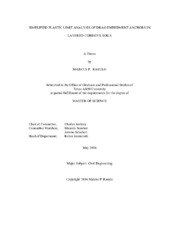| dc.description.abstract | Drag embedment anchors (DEA) are widely used for the temporary, and to a lesser extent the permanent mooring of offshore structures. While they can provide an effective mooring solution, the most commonly used design method, the empirical design charts, leave a high level of uncertainty in prediction of the capacity and trajectory of installed anchors. While this is partially alleviated through the standard of proof loading installed anchors, improved models are needed to help predict the complete capacity and trajectory of the anchors. The presence of layered soils presents an especially complex challenge, which is beyond the scope of most current models. Instead, designers must rely on past experience in the region and designer judgment to estimate if the anchor will be able to penetrate through these challenging soils.
Plastic limit analysis (PLA) allow the incorporation of analytical solutions and geotechnical principles into the design of DEA. In PLA models, the behavior of the anchor is governed by a yield locus, which combined with an incremental kinematic model it can be used to estimate the capacity and movement of the anchor as it advanced through the soil.
The model proposed here is a simplified PLA that assumes a steady state condition as the anchor is embedded. In this state, the anchor load angle or padeye angle is assumed to align with the anchors fluke-shank angle resulting in a condition of zero moment and simplified rotational behavior. The model is then compared to a series of existing design charts, and results from full-scale field installations. To address the issue of layered soils the framework of the model is then expanded to allow for the inclusion of stiff layers of clays. The stiff layers are analyzed through the use of area transformations and multipliers equivalent to the area of the anchor embedded into the layer. As no non-proprietary data is available to validate the model at this time, the model is then simulated through a number complex configurations to see how it captures known behavior. | en |


